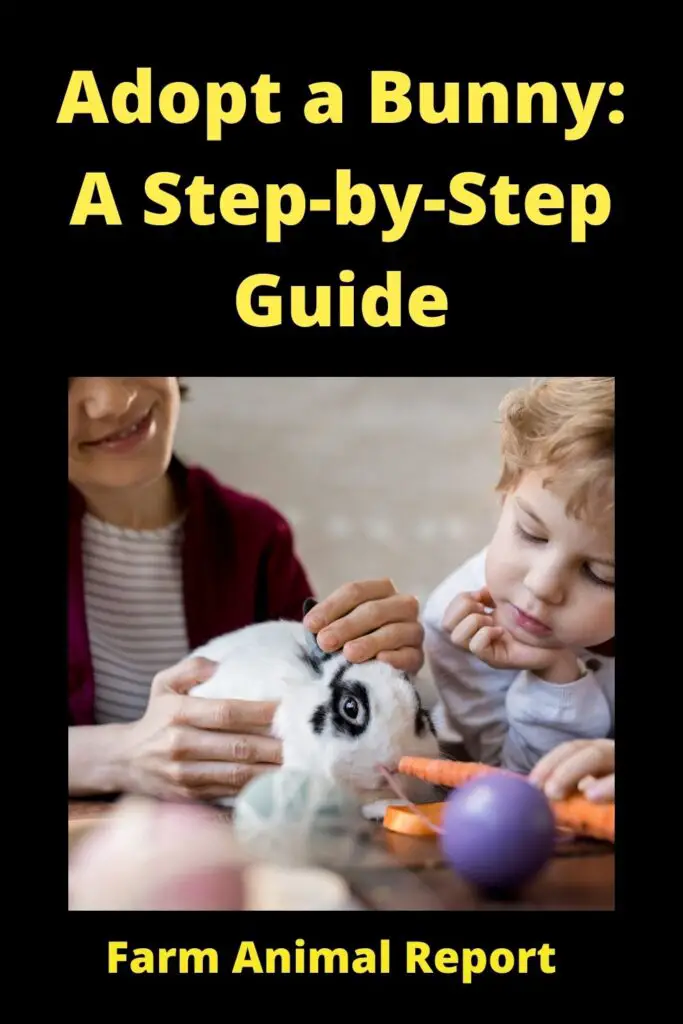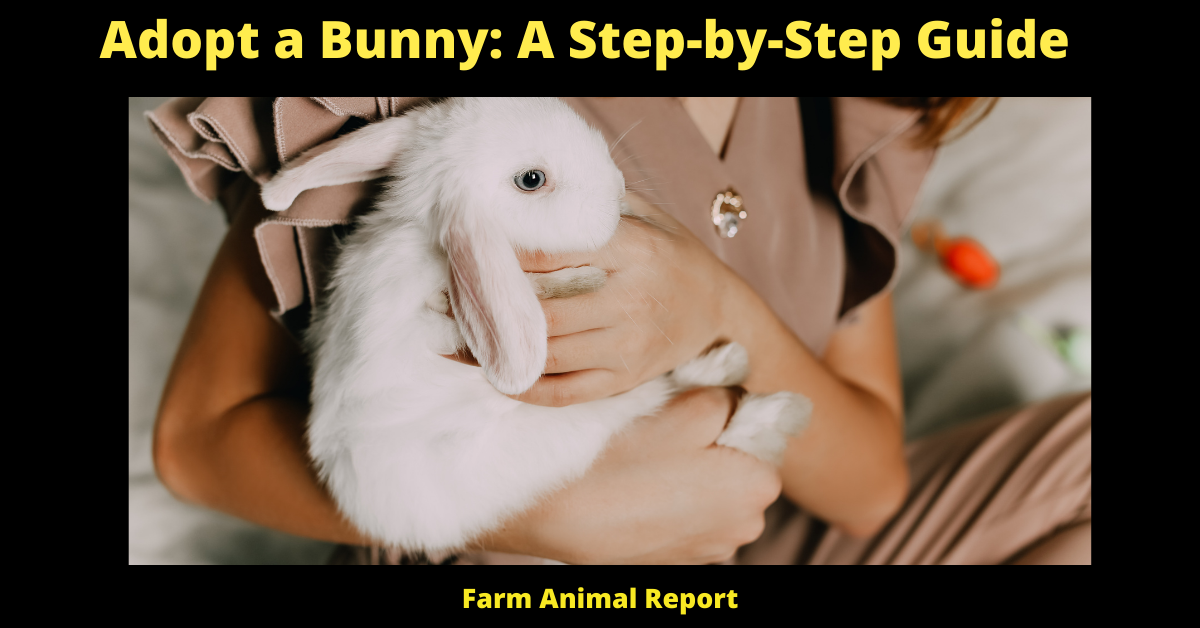As a General Rule Rabbit Adoption Agencies Will provide access to Rabbits needing homes, Housing, and training guides, They will have needed charges to cover their cost. You will need to be pre-approved, Contracts, possibly post-in-home checkups.
Adopt a Bunny
Have you always wanted a bunny, but don’t know where to start? Adopting a bunny is not as easy as it sounds. Adopting a bunny can be difficult because there are so many different types of bunnies in need of homes. Whether you want to adopt an adult bunny or baby rabbit, the process is often difficult and confusing. This article will guide you through everything that you need to know about adopting your very own pet bunny! We’ll go over the adoption process, how much it costs, what supplies are needed for caring for your new pet, and more!
Guardian Angels
People that have a heart for adopting cast aside rabbits that cannot be cared for by their original owner. These special rabbits are often left in shelters to fend for themselves until they find a new loving home or rescue organization.
Guardian angels take these cast-offs and try every effort possible to save the lives of abandoned bunnies, such as fostering them until they can find permanent homes. They volunteer their time, money, and energy to help abandoned bunnies. There are countless numbers of rabbits waiting for their forever home at local shelters across the United States.
Adopting a Rabbit in Need
Adopt a Bunny – Have you ever wanted to adopt a bunny? Adopting your very own pet bunny is not as easy as it sounds. There are so many different types of bunnies in need of homes, whether they’re baby rabbits or adult bunnies.

Why Rabbits Need Rescuing
Many people assume that rabbits are the easiest pets to care for and purchase them without doing much research. However, these adorable little creatures require a lot of work and preparation before they can become suitable housemates!
A person who buys their first rabbit without proper information about caring for bunnies may find themselves overwhelmed and unprepared. Many overworked owners end up surrendering their pets to a shelter. This is good news for bunnies because they can finally find loving homes!
Reasons Bunnies Need adopting
- Original owners Moved
- Kids Grew Up
- Incompatible with other pets
- Rabbits Bred Too Many
- Vet Bills
- More work Than anticipated
What Type of Bunny Is Right for You? –
If you’re still having trouble deciding on what type of bunny is best for you, here are some helpful suggestions! Dwarf bunnies are small and quiet. Beagles tend to be loving with their owners but can become territorial if they feel threatened by other animals or children so it’s important that the family has time to spend bonding with them. Mini rexes are laid back and friendly, but they require a lot of attention every day!
Make Sure You are Good on Your End
Make sure you have thought this through and that your commitment is strong. It would be hard on the rabbit if it didn’t work out again. Pet Rabbits can have a lifespan of 7 – 12 Years’
Bunny care includes feeding, housing, health issues, and more
Once you have adopted your perfect rabbit it’s time to start thinking about what supplies are needed for their care! Before you bring your bunny home, it’s important to think about where they will be living. Will the rabbit live in an outdoor hutch or inside? Make sure that there is enough space for them to move around and get exercise!
Rabbit Supplies you will need
- Rabbit Pen, Hutch, a cage
- Water Bottle
- Bowls for food and water – Ceramic or metal is easier to clean than plastic bowls.
- Food dish/bowl- ceramic, metal, or heavy-duty stoneware is the best choice. They stay cleaner longer and they’re safer because your bunny can’t chew through them like a plastic bowl! Make sure that the bowl is big enough for the bunny to get a full mouth of food.
- Treats – Make sure that these are small and healthy treats, not large pieces of fruit or vegetables! The treat should also be given in moderation because it could upset their stomach if they eat too much at once.
- Hay Rack- Keep fresh hay near the bunny so they have access to it at all times.
- Litter box- You can use an old litter box that you are no longer using or buy a new one specially made for rabbits! Make sure that the type of litter is safe for bunnies and doesn’t contain any harmful chemicals, perfumes, etc.
- Hay – It is important that the bunny has access to fresh hay at all times. This provides healthy fiber and nutrients in their diet!
- Toys- rabbits love to play and they will need lots of toys to keep them entertained when you’re not around, especially if they live inside. Cardboard boxes are a great choice because bunnies like chewing
Do You want a Male, Female, or Senior Rabbit
Each type will have its own type of care needed. Males might need to be neutered that way it will slow down their Territorial and Marking qualities.
Females will need a large area for nesting and they will come into season every so often.
Seniors may have health issues that you will want to be aware of before bringing them home. They will not be as playful. Need a special diet.
Where Do I look
The first thing that you will need to do is identify where the bunnies are located near your home. Many shelters have websites with their location, hours of operation, and contact information listed. It’s important to go visit these places in person because it can help you narrow down which rabbits would be the best fit for you and your family. You can also check with local pet stores, like Petco or Petsmart. Often times there are bunnies that need to be adopted in these areas as well!

What Breed to Choose?
The next step is identifying what type of bunny would work best for you and your family. This can be a difficult task because there are so many different breeds of bunnies to choose from! Some people prefer small, more manageable pets while others want large rabbits that they can get attached to easily. There is also the choice between an adult bunny or a baby rabbit. Many times it’s best if you wait until the bunny is an adult before you adopt them, as babies can be more susceptible to illness. If the idea of a cute baby rabbit all grown up scares you, don’t worry! Many shelters will hold onto bunnies until they are adults if people express interest in adopting them.
How Often Should You Feed Your Bunny?
The next thing that you’ll need to consider is what you should feed your bunny. Many bunnies will eat hay and pellets, while others enjoy fresh vegetables or even fruit! Make sure that your rabbit always has access to clean water as well!
What Should You Feed Your Bunny?
It’s important not to forget about the other supplies that are needed for a happy and healthy bunny! You’ll need to get a litter box, food dish, water bowl, hay feeder, and some toys for your bunny. Make sure that the place you’ve chosen for them to live is easily accessible by all family members so they can be taken care of regularly! It might take time before the whole family has decided on their favorite rabbit, but once you do, they’ll be a fluffy companion for years to come!
Rabbit Shelters
These are run by Rabbit lovers who are trying to find good homes for bunnies in need.
There is a fee associated with this type of adoption because the shelters rely on donations and volunteers to keep running! These places will often have playtime where you can get your bunny used to being around other people before adopting them, which makes it easier if they’re not already used to being around people.
What are the Advantages of Using a Shelter?
The main advantage is that these shelters have an endless supply of bunnies looking for homes! This makes it easier when you’re trying to find the right fit because there will be plenty of options available before making your final decision. The staff at most of these places are also very knowledgeable about the different breeds, so you’ll be able to find out more information on which type of bunny is best for your family.
Do I Need to Spay or Neuter My Bunny?
Many people would love it if their pet rabbit was completely litter trained and could live inside with them! Unfortunately, that’s not always the case, so you will need to spay or neuter them.
Not only does this help prevent unwanted litter and health problems, but it also prevents male rabbits from marking their territory by spraying urine everywhere! This can be a difficult habit to break once they start doing it frequently. If your bunny is not fixed properly then this can be a problem that will continue to get worse over time.

What are the Advantages of Spaying or Neutering My Bunny?
Spaying and neutering both have health benefits for your bunny, but there is also an added benefit of making them less likely to mark their territory with urine! This means you’ll have less work to do in cleaning up after your bunny.
Is Spaying or Neutering My Bunny the Only Solution?
Unfortunately, there isn’t a permanent solution for this problem, but you can find ways around it! You could make sure that they are always litter trained and put in their litter box instead of going on the floor. Another option is to have a second litter box that they can use for going outside of their designated toilet area. If you’re having trouble with this then it’s best to speak with a vet or a staff member at the shelter about how to handle your specific situation!
Rabbit Rescue Groups
Rabbit rescue groups will help abandoned rabbits get rehomed into homes that are safe for them!
These groups will often have a waiting list of bunnies looking to get adopted, so the more people who sign up with their local group then the easier it will be to find good homes. They also run on donations and volunteers which make these places less expensive than rabbit shelters if you’re looking to adopt.
What are the Advantages of Using a Rescue Group?
The main advantage is that these rescues often have lots of options available when it comes to rabbits! They will be able to connect you with bunnies that fit your specific lifestyle and needs because there’s such an abundance of them in need, so you won’t have to worry about not having options.
What’s the Adoption Process Like? Prequalification
Once you’ve found your perfect bunny it’s time to start thinking about the adoption process. Many shelters will have an application for you to fill out that asks questions about your living situation and family. It’s important to be honest with the shelter because they will need to know if your bunny is going into a loving home that can provide them with everything they’ll need!
Adopting tips for successful bonding with your new pet
In Looking to bond with a rescued animal it is important to remember that they may be wary of you. You will need to make sure that the shelter has had time to acclimate your bunny with other humans before sending them home, but it can still take some effort on their part!
Once you get your new pet home then there are a few things that you’ll want to do in order for both of you to feel comfortable and get used to living together. It’s best to make sure that you have a room prepared for them where they can be free, but still contained! Provide things like boxes or small spaces where your bunny will feel safe while exploring their new area.
The bonding process is important because it helps your pet become more comfortable with you. They will learn that you are not a threat and they can trust what you’re doing. If your bunny is used to having their owner around them then this process should be easier than if it’s just starting out with someone new!
Watch His Movements
You can observe the new bunny to watch how he moves, his reaction to you being close to him is important. If he is calm, then that’s a good sign of him being used to human contact. But if it does not seem comfortable with you watching its moves closely and seems uncomfortable near you, back off for now! It might need more time before adapting to your presence or it may be reserved around new people altogether.
If the rabbit wants some time alone, let him be. Rabbits are more comfortable in pairs but they can also live by themselves if you cannot provide them with a pal because of space limitations or other reasons. Make sure that the cage is big enough for two rabbits to move around comfortably!
Two-Way Bonding Process
The bonding process will take time and patience from both of you, but the result is worth it. You will have a companion that can be with you for years to come and provide unconditional love!
After adopting your pet, make sure to take him for regular checkups at the vet’s office so he can lead a long healthy life! He should also get all his vaccinations against disease as well.
Look at his general Health
If you look for the condition of his fur, if seems matted and tangled, then that means he is not very well-groomed. Rabbits usually like to keep themselves clean and will only need a little help with grooming from you. If the rabbit’s fur looks fine but his body has patches of dry skin or dandruff then it may indicate an infection in its respiratory system such as a cold or the flu.
If your pet is healthy, then you will notice that his eyes are bright and shiny with no signs of redness or discharge coming from them. Also, check to see if its nose seems dry or moist because this can mean it’s either sick or has a respiratory infection. If there is also any sneezing involved, then it’s a sign of allergies and you will need to get help from your vet.
The rabbit’s ears should also be clean with no signs of dirt or discharge coming out of them, if they’re full of wax then that is normal because rabbits use their ears like fans in order for their body temperature to go down. If there seems to be a lot of wax then that might indicate an ear infection.
18 Ways to Make Money by Rabbit Farming—Extensive Guidelines for Rabbit Farmers
Rabbit-Proofing Your Home!
You will need to make sure your home is safe for bunnies before letting them loose in the house. If you have not already, get rid of any poisonous plants from your home or yard because rabbits can die from eating even a small amount of it.
If you have wires exposed, make sure to cover them with protective plastic tubing because bunnies like chewing on things, and this can lead to electrocution! Also, check for any electrical cables that are not covered as well so your pet cannot chew through them. If there is a window screen in the room where the bunny is then make sure that the holes in it are small enough for him not to get his head stuck through.
If there is any loose carpeting around your house, either cover them with tiles or area rugs so the bunny cannot chew on them because this can be toxic and may cause intestinal blockage! You will also need to secure everything else in the house that he might find interesting and wants to chew on.
Keep him away from your plants as well because some can be toxic, make sure they’re potted in a material that the rabbit cannot ingest like ceramic or plastic, and keep it out of his reach! Avoiding these things may take time though but keeping them safe will ensure the bunny’s safety.

Keep Things Clean!
If you let your pet roam freely around the house, be sure to check it often for any signs of injury or illness in order for his health to stay optimal. Make sure that all cleaning products are in a place where he cannot reach them because rabbits like chewing on things and this can lead him to ingest chemicals that will poison him.
All of the rabbit’s droppings should be scooped as soon as possible and put in a covered trash can to avoid any bad smells from lingering around your house, also make sure that you watch where he goes because the bunny may go potty somewhere besides his litter box! You might not have known it but rabbits are very particular about where they go potty so you will need to watch them closely.
If there is a water spill on the floor, clean it up right away because rabbits are very curious creatures and might try to lick up whatever liquid fell onto the floor! This can make bunny sick or even kill him if he ingests too much of it. Also, make sure that you give him fresh water every day to avoid dehydration.
Do not forget about the litter box as well, just like all animals he will need his own bathroom and if it’s not kept clean then the bunny might find somewhere else in your house to go potty instead! You can use a small plastic or wicker basket lined with hay or peat moss for him to use as his bathroom.
How Much Does it Cost? Adoption Fees
The adoption process itself can range from $50-$200, depending on where you go and what type of rabbit you’re adopting. Adoption fees also vary depending on the age and breed of your pet, with some bunnies costing upwards of $120!
Rabbit Adoption Agreement
Most Rescue Agencies would insist on you signing an adoption agreement. They have a Very High concern for the future home of the abandoned rabbits.
They want to make sure that you will take good care of it! If they don’t trust your ability to keep the rabbit, then They May Not give you one. This is made clear in adoption agreements. Adoption Agreements are usually very specific about what the adopter can and cannot do, as well as being quite detailed on housing, handling, and diet requirements.
Final Thoughts – The joys of Raising Rabbits as Pets Include
Rabbits are a popular pet because they’re easy to care for and affectionate! They can be great companions, but you need to make sure that you know how to properly care for your new bunny. If not then it’s possible that he might get sick or even die from neglect! In order to keep him happy and healthy, you will need to give him a home that is safe and is free of any dangerous objects or chemicals. Also, it’s important that you clean up after your bunny when he uses the bathroom in his litter box because they can also get sick if their potty area isn’t kept clean!





